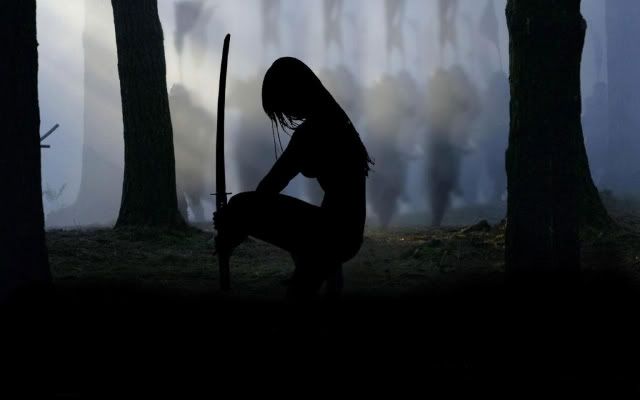
I thought I would post this essay my sensei wrote several years ago. I had read it once before, but when I read it the day before I took my first test in aikido, it had a whole new meaning. It really helped me put things in perspective and I figured it may be just the thing someone else needs to read. Enjoy!
Testing Your Metal (Mettle)
Darrell Bluhm, Chief Instructor, Siskiyou Aikikai, Ashland,Oregon
The most critical phase in making a sword is when the sword is heat treated or quenched. This is the stage in which the curvature of the blade and hardening of the cutting edge are established, and resiliency of the blade reinforced. The process involves coating the blade with clay in a prescribed fashion (thickest toward the back, thinnest along the cutting edge), then heating the blade to a critical temperature and plunging it into water. The differential rate of cooling of the metal that happens due to the varying thickness of clay creates the curvature of the blade and hardens the edge while maintaining a softness and toughness in the remaining part of the blade. This event is the make it or break it point in the sword making process.
At the moment the blade is quenched all of the hours of smelting and forging and shaping that have gone into the metal can be lost, because the blade can break if the smith errs in judging the temperature (too hot) or has inadequately forged the metal. The blade may survive the quench but the curvature desired may not result due to error in temperature (not hot enough) or in applying the clay. The critical nature of this event cannot be underestimated. Swordsmith Michael Bell asserts that the moment of quenching is when the sword takes on its character or soul. It is a moment of truth in the life of the sword that brings together all the elemental forces: Metal, Water, Wood, Fire, and Earth.
The testing process in Aikido bears parallels with the quenching of a sword. As described above, the moment of quenching tests the swordsmith's skill and the strength of the metal's forging . While there are opportunities to confirm the quality of a student's training in the context of daily practice, there is particular opportunity in kyu and dan examination to assess the student's forging process as well as the teacher's skill in transmitting the technical elements of Aikido. The quenching of a sword occurs once in the life of the sword while an Aikido student will mark their progress with many tests and each one can have a formative impact on the student's development. The failure of a sword to survive the quenching process is a much more definitive failure than failing a kyu or dan exam. If the blade cracks the metal must be scrapped and the process begun anew. Failure of an exam, however, does not necessitate seppuku . Both events invite scrutiny to determine the cause of the failure. The sword of course has no means for self-examination, so the reflection is the responsibility of the smith. However, both student and teacher must account for their responsibility in the success or failure of an examination.
The ability to evaluate a kyu or dan test is not based on as concrete a set of criteria as with the sword, it is by nature subjective and complex. The swordsmith must develop the skill to prepare the blade (forge, shape, apply clay, heat to the specific temperature) to enter the water and emerge transformed (from undifferentiated, straight piece of forged steel to a curved, edge hardened, tough bodied blade ready to be polished). The teacher of Aikido must develop the skill to prepare students to meet the challenge of a testing situation and emerge enriched from the experience, sometimes through passing, sometimes by not passing.
As quenching the sword is a make it our break it moment in the making of the sword, the experience of participating in and passing or failing a kyu or dan test can be critical to a student's (and teacher's) development. The responsibility to recognize the readiness of a student for testing is a shared responsibility of teacher and student, yet there are times the teacher must encourage or discourage testing to serve the needs of a student's training process. Over the years that I have conducted tests in my own dojo and participated as a member of the teaching committee for the USAF Western Region, I have come to appreciate the opportunity for growth that testing can provide as well as gained respect for hazards inherent in testing. The decision to take a test, which is based in part on the number of training hours accrued, is not a simple consideration. Acknowledging a break-through in a student's practice can sometimes be best accomplished by creating the opportunity for them to test. At times, when I have not created that opportunity, a student has remained frozen in their progress or given up their practice altogether. At other times, students have tested prematurely and the ensuing frustration or discouragement has led to a rift in their training. This is similar in nature to recognizing when the metal is at the right temperature to plunge into the water. If the metal is too hot the blade breaks, if it is not hot enough, nothing happens.
Preparation for examinations is the shared responsibility of the teacher, students and senior members in the dojo. One of the most valuable benefits of conducting tests in one's dojo is that it fosters conditions for free practice and a deeper exchange amongst senior and junior students. It is important to make clear that advancement in rank in Aikido brings increased responsibility for the care of others in the dojo. One important way that care is expressed is through helping one's juniors and peers train in preparation for testing.
If I observe a student mistaking advancement in rank as a means for increased privilege rather than responsibility, I may use the testing situation to adjust their attitude. Technical proficiency is not the primary determinant in success or failure in the testing process (although it is an important factor). The test can expose strengths and weakness in levels of conditioning, attention to space, sensitivity to others and important qualities of character. The evaluation of any test must be predicated on seeing the individual student in light of their strengths and challenges and not by means of comparison with others or a rigid ideal. Factors of age, personal history, contribution to the care of the community and dojo and commitment to training are important considerations in evaluating an individual's test and promotion in rank. Of course, individuals that are testing for rank that are also actively teaching or seeking to become teachers must be evaluated by stricter standards.
The function of testing in Aikido must be understood relative to two domains, that of the individual within the art and that of the art within which the individual practices. Testing should serve the individual and serve the art. One expression of a spiritual perspective is gratitude for the past, service to the present and responsibility to the future. The student's struggle to perfect the forms that have been passed on to them honors the efforts of O-Sensei and countless individuals whose lives have contributed to the development of Aikido. In the present, testing serves participants as an opportunity for learning under more intense conditions than in daily practice. In that testing is both reflective and rigorous, it addresses our responsibility to the future of Aikido, providing a means to maintain high standards for the transmission of the art.
The transmission of any art is dependent on a vital teacher-student connection and the testing process must affirm that link. The teacher-student relationship exists within a community of dojo, organization of affiliation and ultimately the whole Aikido community. The ranking process must reflect the reciprocal accountability that exists between members of a community. Testing is always a very personal experience and by necessity public, and both aspects should be acknowledged. Aikido testing brings together all the elements of human relationship; relationship to past, present and future, as well as relationship to self, teacher and community.
© Darrell Bluhm 1998


No comments:
Post a Comment